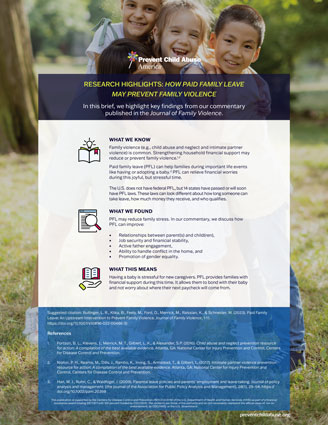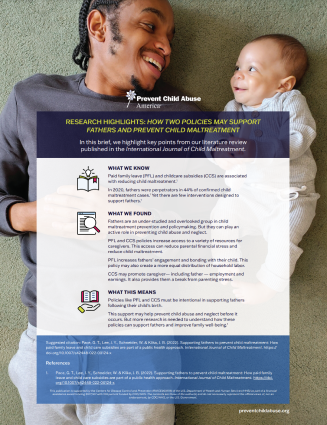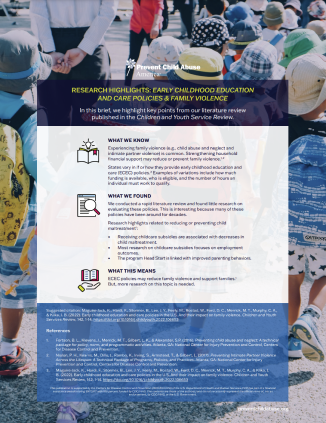Policy strategies for the prevention of multiple forms of violence against children and youth
Dr. J. Bart Klika, Dr. Melissa T. Merrick, Dr. Eric Thibodeau, Catherine Murphy, & Aby Rivera
Introduction
Family violence, like child maltreatment and intimate partner violence (IPV), is a common public health issue. Experiencing family violence has been linked to adverse health and economic opportunity. Yet, child maltreatment and IPV are preventable public health issues.
Effective prevention of family violence relies on a public health approach. Public policies are a public health strategy aimed at addressing the root causes of society’s problems, including family violence.
PCA America is funded by the Centers for Disease Control and Prevention (CDC). This work studies how family-friendly policies affect rates of child maltreatment and IPV. Specifically, we are evaluating paid family leave (PFL) and early childhood education and care policies (ECEC) and their effects on rates of child maltreatment and IPV.
Key Facts
600,000
US children had a substantiated case of child abuse and neglect in 2021, though this is likely an underestimate of the problem.
(1) U.S. Department of Health & Human Services, Administration for Children and Families, Administration on Children, Youth and Families, Children’s Bureau. (2023). Child Maltreatment 2021. Available from https://www.acf.hhs.gov/cb/data-research/child-maltreatment
3 to 10 million
Children witness IPV annually
(2) Niolon, P. H., Kearns, M., Dills, J., Rambo, K., Irving, S., Armstead, T., & Gilbert, L. (2017). Preventing Intimate Partner Violence Across the Lifespan: A Technical Package of Programs, Policies, and Practices. Atlanta, GA: National Center for Injury Prevention and Control, Centers for Disease Control and Prevention.
(3) Smith, S.G., Zhang, X., Basile, K.C., Merrick, M.T., Wang, J., Kresnow, M., & Chen, J. (2018). The National Intimate Partner and Sexual Violence Survey (NISVS): 2015 Data Brief – Updated Release. Atlanta, GA: National Center for Injury Prevention and Control, Centers for Disease Control and Prevention.
Aims of the Project
We hypothesize that supportive family-friendly policies will lead to a decrease in family violence. This project has two aims, studying the effects of PFL (Aim A) and ECEC policies (Aim B) on family violence. Here are our research highlights for each Grant Aim:
Aim B
Differences in state childcare subsidy policies & child abuse and neglect (Klika et al., 2023; Maguire-Jack et al., 2023)
Definitions
Family violence includes:
Child Maltreatment
All types of abuse and neglect under the age of 18 by a parent, caregiver, or another person in a custodial role that results in harm, potential harm, or threat of harm to a child— physical and sexual abuse and neglect are the common types of maltreatment. (4)
Intimate Partner Violence (IPV)
Abuse or aggression that occurs in a romantic relationship, such as physical violence, sexual violence, stalking, and/or psychological aggression. (5)
Family-friendly policies include:
Paid Family Leave (PFL)
A policy that pays workers while they take time off to care for a child or a sick family member. Currently, the U.S. does not have a national PFL policy, so PFL benefits (e.g., length of leave or wage percentage covered) varies by state and employer. (6)
Childcare subsidies
State block grants, funded through the Child Care Development Fund (CCDF), for low-income families. States provide financial help for childcare so caregivers can work or attend qualified job training or education programs. (7)
Note
Note: other early childhood education and care (ECEC) policies/programs, like Head Start or Universal Pre-Kindergarten (Pre-K), may also be reviewed and discussed in our research.
References
- U.S. Department of Health & Human Services, Administration for Children and Families, Administration on Children, Youth and Families, Children’s Bureau. (2023). Child Maltreatment 2021. Available from https://www.acf.hhs.gov/cb/data-research/child-maltreatment
- Niolon, P. H., Kearns, M., Dills, J., Rambo, K., Irving, S., Armstead, T., & Gilbert, L. (2017). Preventing Intimate Partner Violence Across the Lifespan: A Technical Package of Programs, Policies, and Practices. Atlanta, GA: National Center for Injury Prevention and Control, Centers for Disease Control and Prevention.
- Smith, S.G., Zhang, X., Basile, K.C., Merrick, M.T., Wang, J., Kresnow, M., & Chen, J. (2018). The National Intimate Partner and Sexual Violence Survey (NISVS): 2015 Data Brief – Updated Release. Atlanta, GA: National Center for Injury Prevention and Control, Centers for Disease Control and Prevention.
- Leeb, R. T., Paulozzi, L., Melanson, C., Simon, T., & Arias, I. (2008). Child maltreatment surveillance: Uniform definitions for public health and recommended data elements, version 1.0. Atlanta, GA: Centers for Disease Control and Prevention, National Center for Injury Prevention and Control. Retrieved from http://www.cdc.gov/ViolencePrevention/pub/CMPSurveillance.html
- Centers for Disease Control and Prevention. (2021, June). Intimate Partner Violence Fast Facts. Retrieved from https://www.cdc.gov/violenceprevention/intimatepartnerviolence/fastfact.html
- Pace, G. T., Lee, J. T., Schneider, W. & Klika, J. B. (2022). Supporting fathers to prevent child maltreatment: How paid family leave and child care subsidies are part of a public health approach. International Journal of Child Maltreatment. https://doi.org/10.1007/s42448-022-00124-x
- Maguire-Jack, K., Hardi, F., Stormer, B., Lee, J. Y., Feely, M., Rostad, W., Ford, D. C., Merrick, M. T., Murphy, C. A., & Klika, J. B. (2022). Early childhood education and care policies in the U.S. And their impact on family violence. Children and Youth Services Review, 142, 1-14. https://doi.org/10.1016/j.childyouth.2022.106653
Disclaimer
The team will continue to update this page as the project progresses—stay tuned for more research highlights! For more information on the project, click here.
This project and webpage are supported by the Centers for Disease Control and Prevention (R01CE003178) of the U.S. Department of Health and Human Services (HHS) as part of a financial assistance award totaling $977,977 with 100 percent funded by CDC/HHS. The contents are those of the author(s) and do not necessarily represent the official views of, nor an endorsement, by CDC/HHS, or the U.S. Government.







